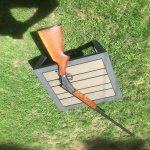I learned to shoot with a Winchester Model 37A, so like others posting here I have a great affection for single-shot guns. My experience with them is that they are simple, well-made, easy to carry and cheap to feed, and as deadly on game as any gun. They also teach marksmanship, as things look very different when you only have one go. I think the tribute gun is fantastic, and I like that collection of Cooeys. I also like being reminded that every gun is someone’s pride and joy, they don’t have to be expensive and rare to be treasured, or to hold treasured memories.
Singles tend to be meat guns, beginner guns, youth guns, and at the other extreme, extra-fancy trap guns – all of which I’m expecting to see in this thread! The Victorians also had a varied relationship with single-shot guns, which generally fell within one of several categories. There were the mighty punt and market guns for shooting at rafts of waterfowl; light game guns for shooters with slight frames; specialty guns for natural history collectors on their countryside walks; concealable poachers’ guns; and guns re-built around a particularly treasured barrel.
Before the days of choke, a barrel that shot well and true was highly prized, and muzzle-loaders were found to shoot better than the early breech-loaders. It is not much of a stretch to picture someone who did not want to lose the patterning quality of their muzzle-loader, asking a gunmaker to build a new breech-loader around that barrel. Some gunmakers specialized in conversions, one of these being Thomas George Sylven of London. He had begun as a journeyman gunsmith in Scotland, making guns for established makers (he worked a short distance from John Dickson and Joseph Harkom, amongst others). He set up his own business in London in 1863, at 33 Leicester Square and 10 Panton Street, Haymarket, and later moving to 44 Bedford Street, Strand, in 1865.
Around this time he built gun number 399 for a client who wanted to re-use the barrel of a muzzle-loading gun built by Richard Seffens, a gunmaker who was in business at 5 St James, Haymarket, from 1820-1825, and at 10 Orange St, Leicester Square, between 1826-1829. Perhaps that gun had sentimental value, or was just a fine-shooting gun. In any case the client wanted to extend the life of the gun while following the latest fashion. The result is quite balanced, and other than the hexagon shaping of the barrel base and the inscribed top barrel flat, you wouldn’t know it was a conversion. The gun weighs 6 lb 1 oz, and the bore is still mirror with only light pitting at the breech. Being a pinfire it is retired from the shooting field, but I expect this might be another 1820s twist barrel that could survive a re-proof.


















































































